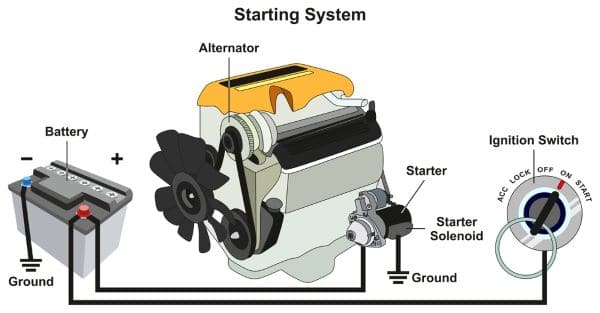The alternator’s role in the health of your car battery is critical. If something goes wrong with the alternator, it can cause a lot of trouble. That’s why it’s important you know how to test an alternator with a screwdriver. While you can test it with a multimeter, not everyone has one lying around the house.

In this article, we will review the steps when you want to know how to test an alternator without a multimeter. You will find that the process is relatively simple and only takes a few minutes. It isn’t much more complicated than learning how to test a starter with a screwdriver.
Table of Contents
What is the Alternator?
The alternator operates like a generator. When you turn the key in the ignition, the alternator begins running with the engine. It’s responsible for producing current for the vehicle and its accessories. It also keeps the battery charged.
How to Test Alternator Without a Multimeter
While you can test an alternator by disconnecting the battery, this method isn’t preferable. Instead, consider using a screwdriver instead. The steps are just as simple as if you were learning how to start a car with a bad starter with a screwdriver.
Here are the three simple steps you can follow.
Step #1: Pop Open the Hood
While you must start by getting into the vehicle, you don’t have to start it yet. Instead, you want to put the key into the ignition. You also need to open the hood for the following steps.
Step #2: Find the Alternator
Near the car engine, you are going to find the alternator. It isn’t always easy to find, but you should be able to reference your service manual if you are having trouble. A quick search online with your make and model could also help.
Once you find the alternator, carefully place the screwdriver by the alternator pulley bolt. This bolt is near the front of the alternator. Nothing is going to happen yet.
Step #3: Turn on the Key
Once everything is set up, you are ready to turn the key until it reaches the ON position. The car shouldn’t start, but you should see all of the dashboard lights come on.
If you put the screwdriver by the bolt on the alternator again, you should feel plenty of magnetism now. The screwdriver should be strongly pulled toward the bolt. If that’s what you notice, the alternator is working.
If you aren’t getting magnetism, there could be something wrong with the alternator, which would require further testing. Additionally, if you tested the alternator with a rusty screwdriver, your results might not be accurate. The rust can inhibit the magnet pull, leading you to believe that the alternator is bad even if it isn’t. If there is rust on your screwdriver, we recommend you get a new one and try the test again, just to be sure.
Signs the Alternator is Failing
If you think the alternator might be failing, you might notice one or more of these tell-tale symptoms.

Inconsistent Lighting
As the alternator fails, you will get inconsistent voltage to the lights, both internally and on the exterior. Most of the time, you will notice that the lights get dimmer, but they can also over-perform, creating a brighter appearance.
Dead Car Battery
There are times when the battery dies because it is old. Other times, the battery dies because the alternator failed to charge it. If you have recently replaced the battery and it dies again, your problem might actually be the alternator.
Malfunctioning Accessories
The alternator is responsible for running all of the accessories when the engine is operating. If the power windows are taking longer, the seat warmers aren’t operating correctly or the speedometer seems out of whack, it could be the alternator.
Trouble Starting/Stalling
When you turn the key in the ignition, the battery helps to start the engine. However, a failing alternator can affect how the vehicle starts and might even make it stall. These conditions could mean that the spark plugs aren’t receiving the power they need to keep the vehicle running.
Whining/Growling Sounds
If you notice a whining or growling noise coming from the engine area, there could be a problem with the alternator. This noise happens when the belt turning the alternator’s pulley gets misaligned or starts rubbing. It can also be caused by bearings that are going bad in the rotor shaft.
Burning Smell
When you smell burning rubber, this is never a good sign. It is a common occurrence when the alternator goes bad, especially because the drive belt is put under a lot of stress and because it is close to the engine. If the alternator is being overworked or has damaged wiring, it can also create an electrical fire-type smell. Whatever the cause, you want to turn off the car at the first sign of this smell or you could end up with a car fire.
Battery Warning Light
When you see the battery warning light come on the dashboard, you know that the battery or alternator is causing trouble. Alternators need to operate with 13 to 14.5 volts. If it starts to fail and drops below capacity, it will send out an alert to your dashboard so you can take swift action. It can also cause the light to come on if it exceeds the voltage limit, helping you prevent any overload to the system.
How Can You Protect the Alternator?
There’s really no maintenance you can perform on your alternator. If it is a high-quality alternator, it will last for many miles. Still, you can check the voltage of the alternator with a multimeter to ensure it is running as it should. If the alternator is allowed to fail, you won’t be able to start the car because the battery’s juice will drain.
Here are a few basic tips that will keep your alternator in its best condition.
Make sure the belt is in good working order: If you want the alternator to last, the drive belt must be working. Over time, the rubber belt will crack and wear out. By examining it frequently, you can catch any problems before they become an issue. Plus, a broken drive belt can lead to engine damage.
Keep the engine bay clean: If you allow debris, dirt and dust to overtake the engine compartment, you reduce the lifespan of the parts that are under the hood. You should regularly clean the area around your engine by wiping away any dirt and debris.
Check the pulleys: As you head down the road, your vehicle encounters a lot of bumps and dips. Very easily, these imperfections in the road can cause the pulleys to fall out of alignment. The crankshaft pulley and alternator must be aligned just right to work well. If there are frayed edges, minor shifts or other conditions occurring with the belt or pulleys, they need to be fixed promptly.
Conclusion
Taking care of your vehicle is your responsibility. While you can take it to an auto repair shop when there is a problem, it’s helpful to know the best way to diagnose faulty parts on your own. By learning how to test an alternator with a screwdriver, you avoid costly diagnostic bills and save yourself some time.
